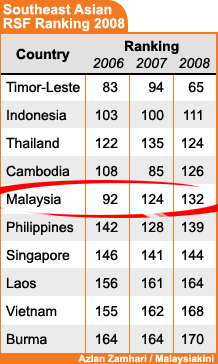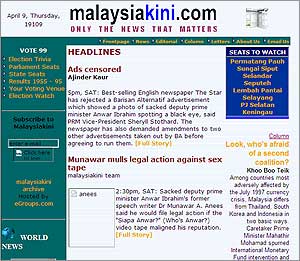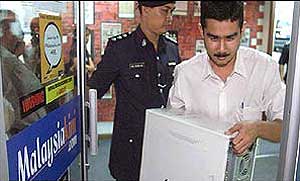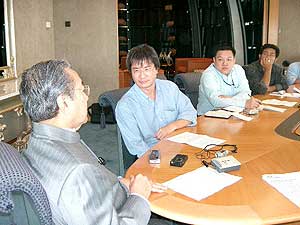To understand the moribund state of the news media in Malaysia, you have to refer to the world press freedom ranking over the last few years.
In the 2008 global index on press freedom released by Paris-based media watchdog Reporters Sans Frontieres (RSF, or Reporters Without Borders), Malaysia crashed to the bottom quarter of the 173 countries surveyed.
The number one ranking has been shared by Iceland, Luxemburg, and Norway, with UK at 23, Japan at 29, and United States at 36.
 Malaysia fell eight places from 124 in 2007 to 132 in 2008, firmly behind other Asian nations such as Timor Leste (65), Indonesia (111), Thailand (124), and even lowly Cambodia (125)!
Malaysia fell eight places from 124 in 2007 to 132 in 2008, firmly behind other Asian nations such as Timor Leste (65), Indonesia (111), Thailand (124), and even lowly Cambodia (125)!
We who love and work in Malaysia all our lives know our national media well. The large media conglomerates are all owned by companies either controlled by the ruling political parties or their cronies. They are the very embodiment of crony capitalism at its best.
They form the hegemonic instrument for the monopolistic propagation of the grand national narrative created by Umno and their side-kicks in the Barisan Nasional. The journalists there sing the hymns of what historian Eric Hobsbawm calls “official nationalism”.
In short, the Malaysian mainstream media is the most powerful weapons in the hands of the ruling elite to dominate the national conversation, to create a one-dimensional and uni-directional worldview of the citizenry so that all other discourses will be exiled to the remote margin. It perpetuates political power for the ruling BN coalition.
If the national media is a mirror that reflects our national soul, then our Malaysian media is an opaque and cracked mirror.
Paradoxically, the Malaysia media remain a great commercial success story. That is probably because the Malaysian audience had no other choice. They have probably accepted this role for the media because they know no other form of journalism.
 That is why the appearance of
Malaysiakini
in November 1999 was such a momentous event in the history of our nation. Those visionary pioneers in this brand new Internet newspaper shows what independent journalism that aspires to international standards of journalistic standards such as “credibility, independence, fairness and accuracy” can be like.
That is why the appearance of
Malaysiakini
in November 1999 was such a momentous event in the history of our nation. Those visionary pioneers in this brand new Internet newspaper shows what independent journalism that aspires to international standards of journalistic standards such as “credibility, independence, fairness and accuracy” can be like.
Unlike many amateur blogs, Malaysiakini has always been professional, sticking to the same professional rules observed by credible international media organisations.
Even in those early times, Malaysiakini filled a vacuum for “real” news, and for Malaysians who suffered from a ravenous hunger for news and views from the margins, the news and views served up by Malaysiakini every day were like water to a thirsty man in the desert.
In an interview with PBS news host Terrence Smith upon winning an international award one year after the launch of Malaysiakini , editor-in-chief Steven Gan had this to say, “We have news stories that are not being reported by the mainstream media every day, and that is why we've been so successful; we've gone from zero to a hundred and 20,000 visitors a day.”
Malaysiakini’s mission statement states:
“To use information technology and the Internet to provide fresh, free, fair and fast news to the Malaysian public so as to set new standards of journalism and to support the development of freedom of speech, social justice and democracy in Malaysia.”
What Malaysiakini set out to do then was to demonstrate how a media organisation can play the true role of the Fourth Estate - outside the three branches of government - as an additional arm of checks and balances.
Their groundbreaking achievement was immediately recognised by international media watchdogs. Within a year, Malaysiakini won the following international accolades:
- Reporters San Frontiers’ Press Freedom Award 2000
- Committee to Protect Journalists’ International Press Freedom Award 2000
- Asiaweek’s 50 Most Powerful Communicators in Asia 2000
- International Press Institute’s Free Media Pioneer Award 2001
 Naturally,
Malaysiakini
was most critical of the government, leading many BN politicians and partisan senior civil servants – especially the police – to perceive
Malaysiakini
as “anti-government”.
Malaysiakini
reporters have seldom been invited or permitted to attend government functions and ministers’ press conferences.
Naturally,
Malaysiakini
was most critical of the government, leading many BN politicians and partisan senior civil servants – especially the police – to perceive
Malaysiakini
as “anti-government”.
Malaysiakini
reporters have seldom been invited or permitted to attend government functions and ministers’ press conferences.
Politically engaged, yet non-partisan
From the very early days, the Malaysiakini team had obviously given plenty of thought to what journalistic independence meant.
A publication can be politically engaged, independent, and yet non-partisan at the same time. This has caused some unhappiness among opposition supporters in the past whenever Malaysiakini highlighted the internal problems of the Pakatan Rakyat.
Within the political culture of Malaysia for the past 60 years, non-partisan news media has never existed until the appearance of Malaysiakini . Naturally, many strong supporters of the Barisan Nasional and now Pakatan have been infested with this mentality that “if you are not with us, then you are against us”.
Actually, on any important issues of the day, things are not as clear cut as black and white.
Independent journalism does mean giving both sides of the political debate equal time and equal space. Over the years, I have noticed how Malaysiakini editor-in-chief Steven Gan has deliberately pursued this policy.
And even “rubbish” that I hate has seen sunlight on his site. In fact, it is this sort of independence that will nurture a different form of public space for healthy debate to take place on those burning issues of the day.
In his book ‘Contentious Journalism and the Internet: Towards democratic Discourse in Malaysia and Singapore’ by Cherian George, Gan was quoted as saying this about his reporting staff, “I tell them, you can take positions, but you must include the other positions, even in opinion pieces.” That is the kind of editor very much after my own heart.
While Malaysiakini is striving towards financial independence, it is strictly speaking not a commercial project per se. We all know that. They are not there to make big profits for themselves and the shareholders, like the newspapers and the TV stations.
What they try to do is more like journalistic activism, to blaze the trail on how good journalism can be done. They have already expressed their activist ambitions very clearly in their mission statement - to “set new standards of journalism and to support the development of freedom of speech, social justice, and democracy in Malaysia”.
Based on this mission statement alone, there is no doubt that Malaysiakini has achieved its goals, and more.
Today, Malaysiakini has succeeded and thrived because as an activist movement in journalism, they have struck resonance from many Malaysians in and outside the country. Today, they are published in English, Bahasa Malaysia, Tamil and Chinese. They have a vibrant section for vivid and dramatic videos. They even have a lifestyle section!
On Nov 28, Malaysiakini is going to have a big bash to commemorate their 10th anniversary. In hindsight, the achievement looks easy. But 10 years ago, Malaysiakini looked like Mission Impossible.
 I sent an email to Gan on what his most gloomy day was in all those angst-filled and laborious years in
Malaysiakini
.
I sent an email to Gan on what his most gloomy day was in all those angst-filled and laborious years in
Malaysiakini
.
His reply was this: “My most gloomy moment was realising Malaysiakini was doomed just as we were making an impact. That was in 2001, in the aftermath of the dotcom bust where most of our Internet start-up advertisers disappeared virtually overnight.
“It soon dawned on us that advertising alone would not be able to keep Malaysiakini afloat financially. Our decision to go subscription was really the last resort. We hated doing it, but we had no choice.
“We didn't even think it would work, but there was no harm in trying - after all, we would have to close shop anyway.”
I asked him what his proudest moment was, and he replied, “It was March 8, 2008 - I never thought I'd live to see the day that Malaysians would wake up from their slumber and discover the power of the vote.”
Of course, our common struggle for freedom of speech, social justice and democracy is far from over, and the road ahead is long and winding. But I can look forward to the day when all the media in Malaysia can practise the kind of independent journalism like Malaysiakini .
By then, Malaysia will squeeze into the top 50 of the international media ranking and the existence of Malaysiakini may become superfluous. Fortunately for Malaysiakini, that day is not going to come anytime soon.
Happy 10th Anniversary, Malaysiakini !
SIM KWANG YANG can be reached at [email protected].
A Malaysia without Malaysiakini...
 Malaysiakini
is celebrating its 10th year anniversary on Saturday, Nov 28 with a gala dinner at the Sime Darby Convention Centre in Bukit Kiara. Be there! Seats available from RM100.
Malaysiakini
is celebrating its 10th year anniversary on Saturday, Nov 28 with a gala dinner at the Sime Darby Convention Centre in Bukit Kiara. Be there! Seats available from RM100.
Click here for more information.

